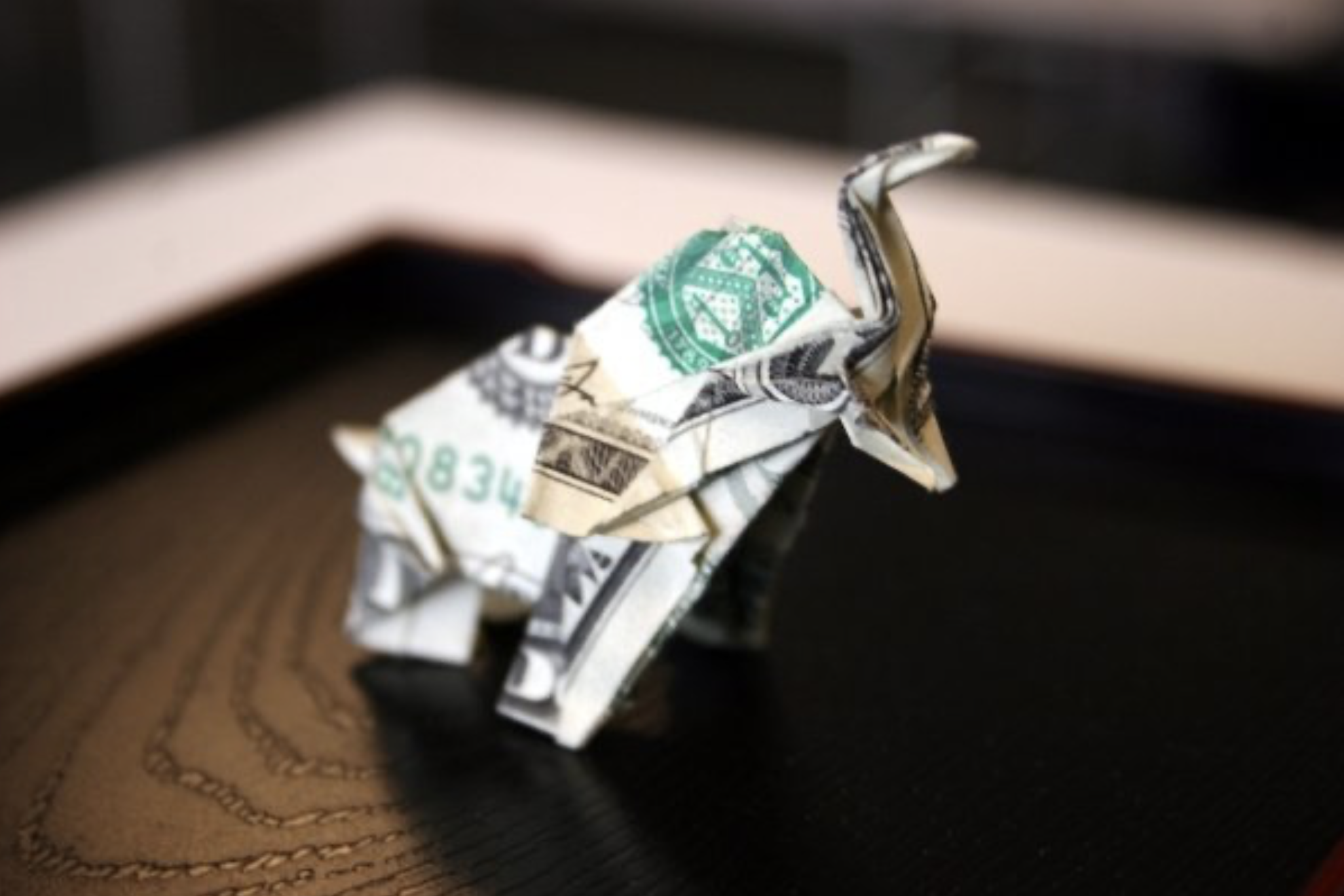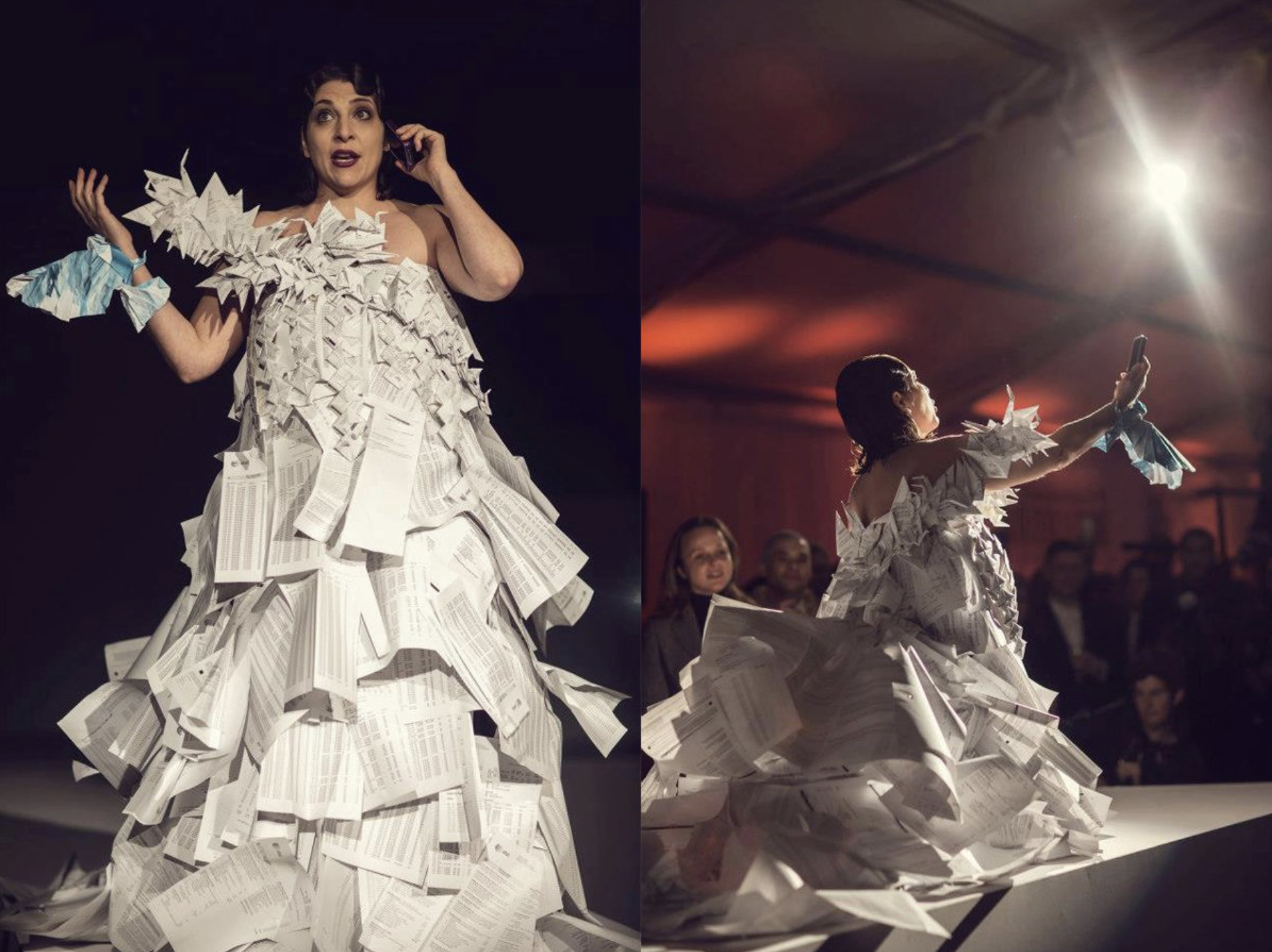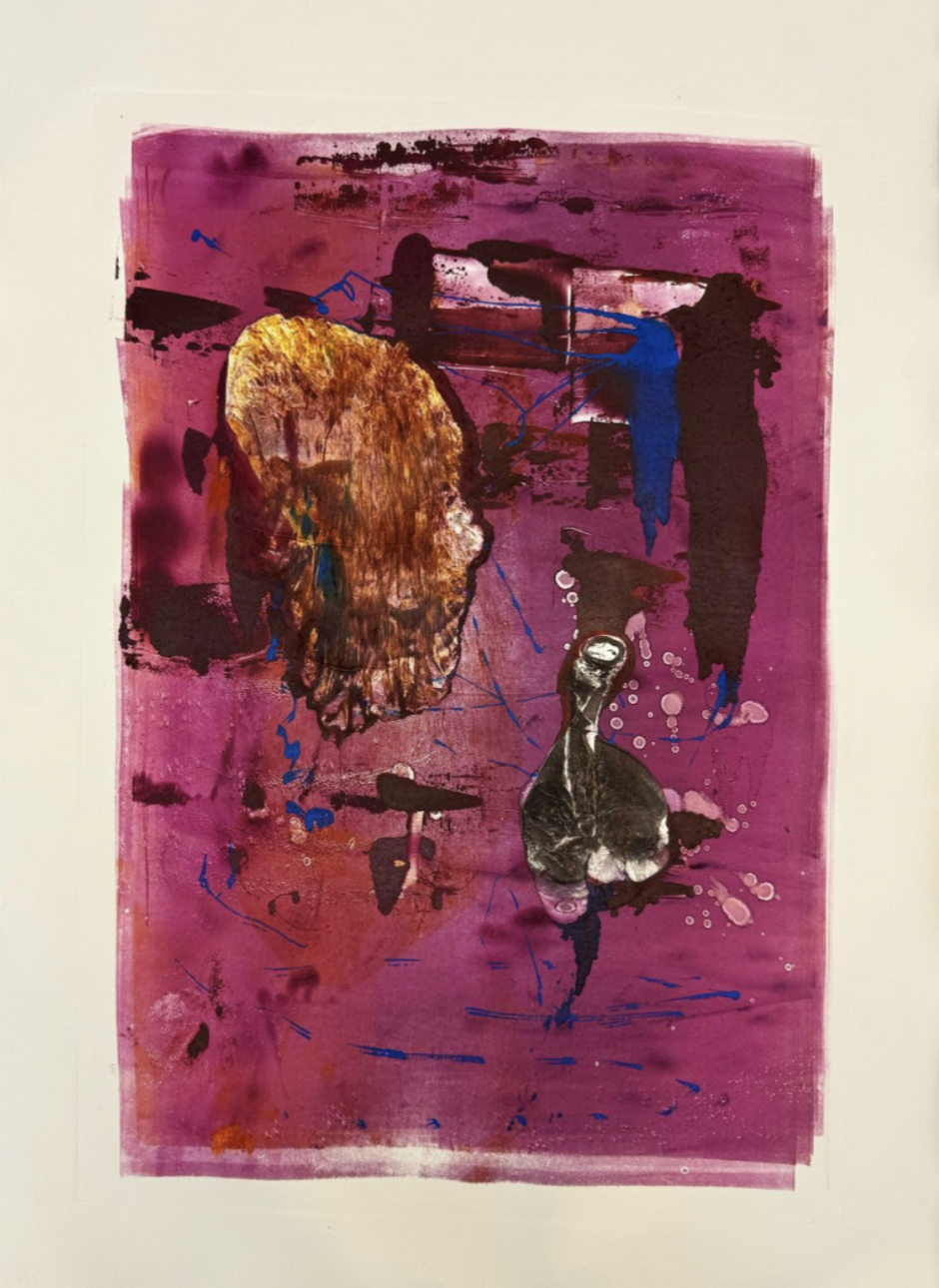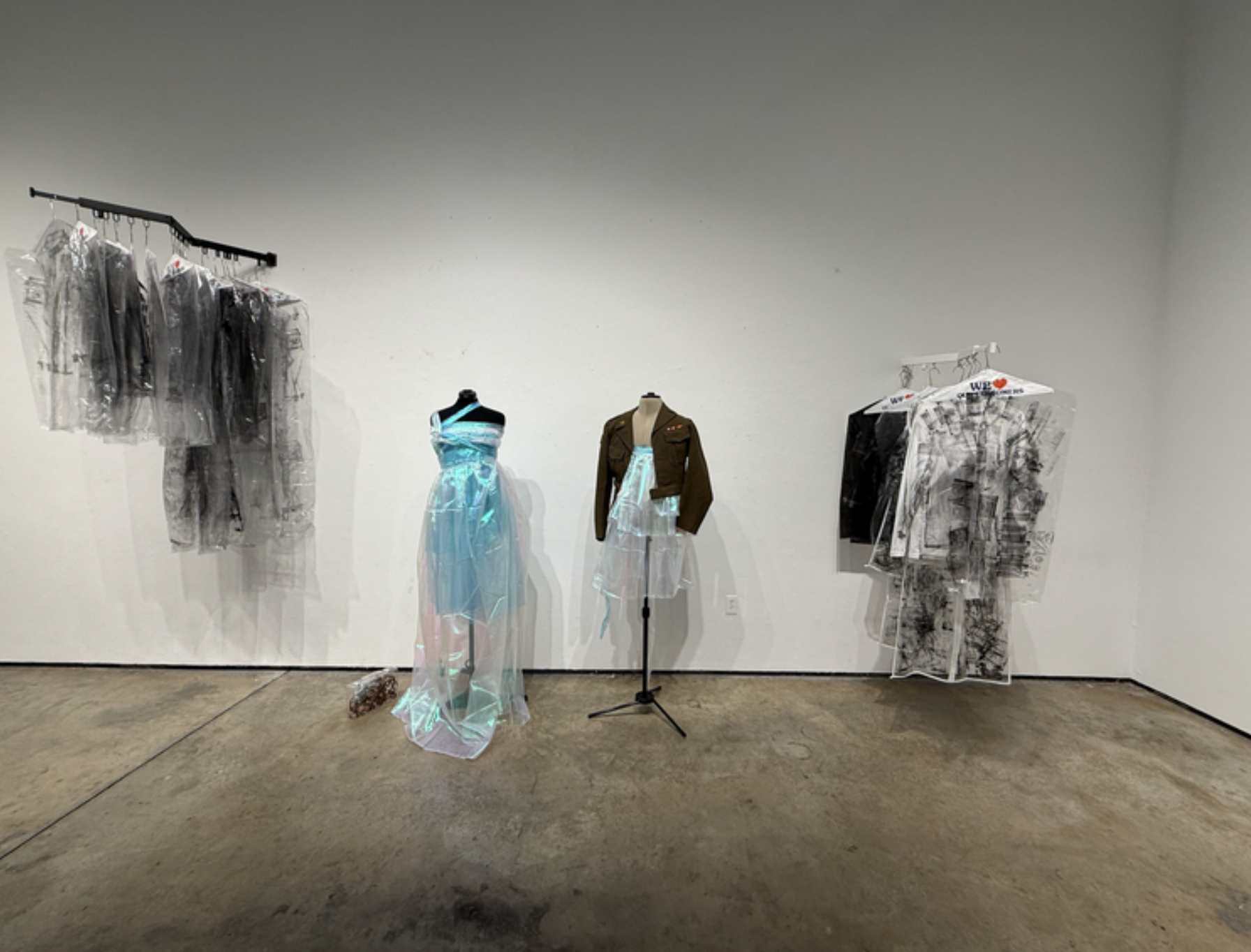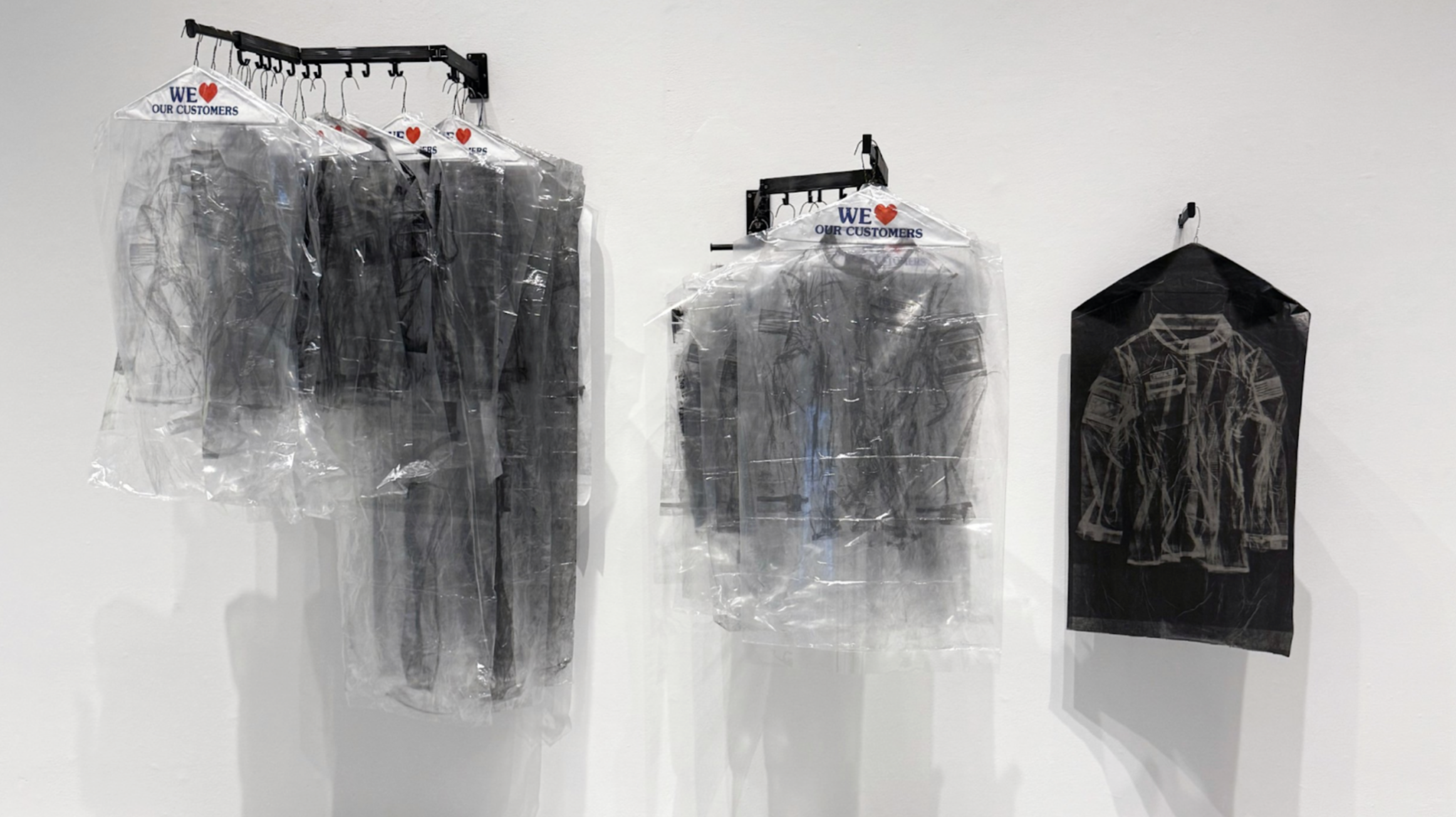Folding Reveries: In Conversation with Sok Song
Sok Song is a master of origami. Song speaks with Lara Xenia about his approach to geometry, his Korean roots, and material experimentation with mediums.
Figure 1: Sok Song, Korean or American Army?—Uniform Duality, 2024, graphite transfer collograph and pressure print monotype on BFK Rives, 30 × 22 (76.3 × 55.88 cm). Photo: courtesy the artist © Sok Song
Lara Xenia: What's the first thing that comes to mind from your childhood bedroom?
Sok Song: I don't think we had a lot of personal things in our rooms. I have three brothers, so when we were younger, two of us shared a bed with our grandma, and the other two stayed in a bunk bed in the same room.
LX: That reminds me of Mar’s background! I was fascinated by how your works explore origami on a completely different front, and sometimes take up the entire room. How did you get obsessed with it?
SS: Yes, I started origami when I was little…maybe six or seven. I remember very vividly that my brothers and I would play this game in Korea called dakji. It’s very similar to the American bottle cap game, where you flatten bottle caps and try to flip over your opponent’s by slamming yours down on top. But with dakji, you fold square pieces of paper into thick tiles then each player takes turns slamming their tile onto the opponent’s to flip it. If you manage to flip it over, you win that round—and sometimes you even win the opponent’s piece. It’s a classic flipping game, like the one shown in Squid Game, where the guy in the subway gets slapped every time he fails to flip it. Almost every Korean kid knows how to play it. All the neighborhood kids played it as well.
LX: Interesting. Were you competitive with your brothers?
SS: So competitive [laughs]. My mom was especially angry because it requires paper and growing up, there was paper, but it was from the newspaper or the magazine, phone books, or any kind of paper calendar. We would take any paper that was in the house to make stock. She would be so annoyed that we were using any kind of paper, some important papers. I distinctly remember having a giant black trash bag filled with papers that we’d hold onto and sleep with, to say, “You can't steal this. I want all of this.” [Laughs] From a young age, I knew that I was gonna start collecting papers. Now, I have a different type of paper collection [laughter].
Figure 2: Sok Song, Dollar Bill Teddy Bear, 2010. Photo: courtesy the artist © Sok Song
LX: That's so funny. Growing up, we had this old-school Dell computer for the whole family. Sometimes you’d wait for four hours for it to load something. Next to it, we kept a stack of our recycled scratch paper for notes and doodles. I feel like no one does that anymore now that we barely print things. What compelled you to start making origami so seriously?
SS: When I moved to southern Arizona from Korea when I was eight, I stumbled into a library and checked out an origami book with dragons on the cover. I was hooked. I started looking for other books on folding from there. After I moved to New York, I found out that there's a national organization called Origami USA headquartered there that holds multiple conventions in the country. Every year, 500 people come from all over the world to teach origami and take classes. I started volunteering for it and ended up designing the Origami Holiday Tree at the American Museum of Natural History. Funnily enough, Origami USA is housed in the museum’s basement, after one of the former curators endowed it with that space in exchange for visitor services aid and designing the tree. So the Origami Tree has been a museum fixture and tradition for over 55 years. Since I designed it for seven years, I still consult with them annually for when it goes up every November.
Figure 3: Installation view of the Origami Holiday Tree, Fantastic Creatures: Mythic and Real, 2007, The American Museum of Natural History, New York City. Photo: courtesy © The American Museum of Natural History
LX: That's so pretty. I also noticed that you write your own didactic books.
SS: Yes, when I started doing the tree, Random House asked me to do my first book, but then I started traveling to other countries with the organization to attend origami conferences, so I got immersed in a very niche community. Every country has their own organization and hosts biannual conferences. When you start taking classes, and reading hundreds of origami books, you start thinking about how to make other things. I was teaching, making, and designing objects for the other conferences, so those were all included in my publications.
LX: What centers you when you're making the work?
Figure 4: Sok Song, Dollar Bill Elephant, 2010. Photo: courtesy the artist © Sok Song
SS: I like that origami has mathematical principles. There are only certain ways that you can transform a flat, square piece of paper into a three-dimensional shape. Some designers think mathematically, and use computers to design the internal structures of the folds. But I’m more of a doodling, trial-and-error type of person. If I want an elephant, I know that I need to get a long trunk and flat ear, so I instinctively know how to fold the square into that base. Then I experiment, like do I want the ears a little bit bigger or the trunk a little longer. There’s a subconscious mathematical geometric thinking that's happening. I try different things to see what it's going to turn into. Sometimes I will just doodle and fold unknowingly, and it'll turn into something.
Figure 5a: America’s Next Top Model, Cycle 12, 2009, origami vêtements. Photo: courtesy the artist © Sok Song
Figure 5b: Sok Song, Origami Phone Bill Dress, Fashion Week 2015, origami vêtements. Modeled by Tara Sukoff for Imitation of Christ. Photo: courtesy the artist © Sok Song
I like that origami has mathematical principles.
Art as a practice came fairly late because I was teaching workshops and doing origami installations and the origami job at the Museum of Natural History in New York for a while. I started publishing the books, and then I started doing custom paper sculptures for events in New York, or teaching at schools and parties. Part of me really wanted to try to see if folded objects and sculptures could become fine art. Yet, it was very much an uphill battle because there's a divide between art and craft. Origami is seen as more of a craft, or a childhood activity, rather than as a high art form or sculpture.
There are basically two types: the geometric, representational kind—like cranes made of sharp edges and triangles—and the more organic, lifelike origami, where you sculpt the paper into a person with a jacket and buttons, or an insect with antennae and legs. Still, as soon as people hear the word “origami,” something shifts; they think of kids and craft, and that changes how they see the work. I used to call myself an origami or paper artist, but just saying the word always shaped the conversation, whether I was in the U.S., Japan, or Korea.
Figure 6: Sok Song, Rupture under Pressure, 2025, balloons and charbonnel ink monotype on BFK Rives, 30 × 22 (76.3 × 55.88 cm). Photo: courtesy the artist © Sok Song
Before the pandemic, I thought about going into education because I’d taught at every private school and a lot of public schools in all five boroughs of New York, but most of the full-time positions required a Master’s or an MFA. During the pandemic, when online classes became accessible, I decided to finally finish my Bachelor’s, which I had started at Parsons but I dropped out of a fashion degree. I completed my BA through CUNY Hunter, where I also took studio art classes and got some guidance on MFA applications. I graduated in 2024, applied to Yale as I was finishing, and by some stroke of luck or chance I got in, along with a few other schools. I took that as a sign to immerse myself in it.
LX: No way—wow! I don't think so by chance! You’re very talented, and I think that’s exactly what made your practice stand out to me. It’s amazing how you’ve elevated origami into such a refined art form. I don’t know if anyone else at Yale has focused on it the way you have. I think it’s so cool that you’re redefining an entire category of fine art and sculpture through your prints and origami-based works.
SS: I was trying to do that when I was at Hunter too, incorporating folding into all the fine art mediums. I folded canvases and paintings. I folded clay, metal, and sculpture, made videos of folding things to try to see what would stick. Printmaking had the most synergy because printmaking is very much like origami. It's systematic. You have to do this first, then you have to do that and to prepare the plate. It’s step-by-step, just like origami.
Figure 7: Simon Hantaï, Étude, 1969, oil on canvas, 108.25 × 93.69 inches (275 × 238 cm). Gift of the Collectors Committee, National Gallery of Art, Washington, D.C. Photo: courtesy The Estate of Simon Hantaï © 2012 The Estate of Simon Hantaï
Figure 8a: Francis Bacon, Portrait of Henrietta Moraes, 1963, oil on canvas, 65 × 56 inches. (165 × 142.5 cm). Photo: courtesy The Estate of Francis Bacon © The Estate of Francis Bacon
Figure 8b: Francis Bacon, Three Studies for Portrait of Henrietta Moraes, 1963, oil on canvas. Triptych, each panel: 14 × 12 inches (35.5 × 30.5 cm). Photo: courtesy the Museum of Modern Art, New York, New York
Figure 8c: Francis Bacon studio material, John Deakin, Henrietta Moraes, late 1950s, Collection Dublin City Gallery The Hugh Lane. Photo: courtesy John Deakin Archive © John Deakin Archive and The Estate of Francis Bacon
Printmaking had the most synergy because printmaking is very much like origami. It's systematic.
LX: That’s such an interesting point you make—especially when you think about folding in the context of other artists. For instance, Simon Hantaï famously folded his canvases while painting, and even Francis Bacon manipulated photographs in fascinating ways. I actually wrote my undergraduate thesis on Bacon and his use of photography. He would often fold aide-mémoire photographs cylindrically to distort and adapt them as references for his paintings. This one looks like a literal Mandelbrot fractal [laughs whilst pointing at a work].
SS: Yes, I made a lot of this in my first year at Yale. I am learning more about contemporary artists and others that have used the basics of folding at YUAG. I’m always fascinated by paintings where you can see the folds, like Sam Gilliam paints, folds all of his canvases as they paint them, and then stretches them out. There are artists who use folds to block things out while they paint and unfold to see what happens when they use folding. It seems even here at YUAG, one of the guest Teaching Fellows folds his canvas and then paints it, then opens it and paints it again.
LX: I never thought of the parallels between origami and folding techniques by artists until now. Could you tell me about that amazing print series in your studio with the Korean flags on them?
SS: I first started experimenting by putting folded paper through the printmaking press and noticed how each layer left a different imprint. I wondered, “What if I pressed clothing?” Because of my interest in textiles and fashion, I became fascinated by how every fold, seam, and layer of fabric created varying tones, especially when using graphite transfer paper. One layer might leave a faint gray, while multiple layers produce deep black marks due to the pressure of the rollers. This made me think more about the construction of clothing and my own identity—especially traditional Korean garments, like the hanbok, which are tied together entirely through fabric. I was struck by how these clothes are designed to fit the body without modern fasteners like zippers or darts, and how that reflects both the cultural tradition and function. All in all, the technique took me about two years to formally develop.
Figure 9: Sok Song, Installation view of Forgotten Heroes, 2025, hangers, dry cleaning plastics, vêtements, and mannequins, dimensions variable. Photo: courtesy the artist © Sok Song
After my niece and nephews were born, they each wore colorful Korean garments for a traditional 100-day celebration. As part of the ceremony, symbolic objects are placed in front of the baby, like a brush for an artist or a calculator for someone going into finance, and whichever item the baby grabs is said to predict their future. It always struck me as a strange, stereotypical pressure to place on a newborn, and it got me thinking about traditional culture, garments and my own upbringing. My family immigrated to the U.S. because my aunts married American military men stationed in Korea, and we came on an extended family visa. We lived near military bases in Arizona and Texas, so southern Arizona was Fort Huachuca, and Fort Hood in Texas. Near the base, my parents worked in Korean restaurants and a dry cleaner that served soldiers—our lives in the U.S. was always shaped by that military connection.
LX: So the uniforms they were laundering were all American military uniforms?
Figure 10: Sok Song, U.S. Army undressed, 2025, from the A.P.T. (Air, Pressed, Transferred) series. Photo: courtesy the artist © Sok Song
SS: Yes, they are American military uniforms. But I sewed one side of a Korean-American Korean flag, and one side with an American flag because I felt like that's where I grew up. It is this weird niche intersection of Korean-American military presence.
LX: How has that presence impacted you?
SS: As a Korean citizen with a U.S. green card, I’ve had to file regular waivers to avoid mandatory military service in Korea—if I didn’t I could be arrested upon visiting. Korea doesn’t allow dual citizenship, so becoming a U.S. citizen would mean giving up my Korean nationality entirely. I’ve considered naturalizing, but hesitated, because I was unsure if I might want to return to Korea someday. It wasn’t until the pandemic that I realized how fragile green card statuses are—staying abroad for over six months can lead to losing it, even after a lifetime of living here in the U.S. It’s so crazy because I feel like I've lived here my whole life, but it doesn't really count because of this little card status.
LX: Is that another thing that maybe you would explore, like the idea of a paper identity card?
Figure 11: Sok Song, Folded Identity Portrait, 2025, Ben Day dots on paper, 30 × 22 inches (76.2 × 55.88 cm). Photo: courtesy the artist © Sok Song
SS: Yes, a lot of the things that I was doing the first semester here had to do with the protection of identity. My first project was folding faces and folding portraits of identity photographs of people in my community, like my friends and the people who were international students at Yale because I was also turning them into halftone dot printing, like Ben Day dots. It obscures the identity. If you step really far away from it, you can see the picture, but if you're up close, you can't see whose face it is.
LX: That’s intriguing. Do you proudly identify with your Korean identity? I grew up in LA, so I personally had a lot of exposure to really amazing Korean restaurants and cultural festivities, but I was wondering, did you have a community that you were able to foster when you first came here that let you really relish in your culture?
SS: Yes. I’m always there—I came here when I was eight, and my parents made us go to Korean school and Korean church. I still speak Korean to my parents all the time, even though they are fluent in English because they had to run an American business, but it’s more comfortable to speak to them in Korean. There are lots of things that I feel very proud about in the Korean heritage. I feel there's also a lot of things that weigh on my mind because every time I go to Korea, I feel the weight of the whole north and south division. I'm constantly trying to think of ways of how that plays out in my art and how I think about my identity.
It’s a small, niche community centered around U.S. military bases. When I got to Yale, I even reached out to the Korean Studies librarian to explore it further. It has to do particularly with military brides that come over as a result of American military presence in a certain country. I grew up in that world, attending church two or three times a week with 200 Korean women who were married to American military men. Our churches in Fort Huachuca, Arizona and later Fort Hood, Texas were community hubs and religious centers, with language classes, taekwondo, Sunday school, and shared meals every week. Everyone knew each other, celebrated milestones like 100-day birthdays together, and helped preserve Korean culture for the next generation.
LX: I love that. Tell me about your inspiration for the balloon-filled crit installation.
Figure 12: Installation view of Rupture and Reverie: Air Pressure Manifolds, 2025, Yale MFA Pit Crit. Photo: courtesy Chen Xiangyun and the artist © Chen Xiangyun
Figure 13: Installation view of Rupture and Reverie: Air Pressure Manifolds, 2025, Yale MFA Pit Crit. Photo: courtesy Chen Xiangyun and the artist © Chen Xiangyun
SS: I don't think I saw helium balloons, until going to birthday parties of my friends in school. I was always fascinated by them. At Yale, that turned into a pit project after my cohort surprised me with a birthday movie night. Mar had ordered “Happy Birthday” balloons, but they accidentally came as “Happy Valentine’s Day” balloons in Spanish [laughs]. It was hilarious. I kept those balloons in my studio for weeks, watching them slowly deflate, and became really intrigued by their emotional resonance of being object at times for celebration, joy, and even fear—especially with the anxiety around them popping. My studio has almost no ventilation, so the balloons lingered and were constantly shifting. When it came time to plan my final pit crit installation, which we only have one each semester, I wanted to use the full height of the 30-foot space, but we weren't allowed on tall ladders due to liability rules. So I thought, “What if helium could do the lifting for me?” I installed around 200 balloons, each tied to prints of uniforms and clothing I’d made. I even directly printed some things onto the balloons. Viewers had to pull the balloons down to see the work or pop them to get a print hidden inside. It turned a limitation into an immersive, interactive experience and space.
LX: That's so cool is that something interactively you want to continue with in your practice of this immersive experience within your work. What made you choose graphite for your pit crit?
SS: Because my background in origami is rooted in sharing and interactivity, I’ve always believed a design doesn’t fully come alive until it’s taught to someone else. I love the ripple effect of teaching a fold at a convention and watching it spread. That communal spirit has molded my MFA work, from the exploding balloon pit crit to my final review, a fashion show involving students from all departments. I find joy in making experiences participatory.
For the pit crit, I transformed the space using graphite lines on the floor, plastic boots for participants, and balloons tied to prints. The idea was for people to walk through and leave subtle graphite footprints, to echo the graphite transfer prints on the walls. But as soon as it started, everyone began sliding around—the graphite powder, which is a dry lubricant, made the floor slick. A huge cloud of graphite filled the air, and people asked if it was toxic…it’s not, it’s just an irritant, but luckily, I had N94 masks ready just in case. I think I mentally blacked out. It was chaotic and funny, and not at all what I expected, but it created a much more physical, immersive experience than I’d planned.
LX: Do you have a video of this? I would love to see.
SS: Yes, I can send it to you. It was really, really interesting. I don't remember it happening at all because it was not what I expected. It was really generative, and the conversation that it brought out about mark making and leaving traces, and ended up doing what I really thought I wanted, or what I was planning, but I thought they would be more gentle with the steps, but nope, you just it was what it was at the end of the day, after two days of crits, I think everybody wanted to let out some steam. When they were told they could just walk around and slide around and graphite, they've never done it before, so they went all over the place.
LX: I mean, that's also great. It's a contained area, and what a better cohort to do that with and literally frolic in graphite. Are there any artists that you also like are inspired by?
Figure 14: Do Ho Suh, Installation view, Home Within Home, 2013, National Museum of Modern and Contemporary Art, Seoul, Korea, 2013–2014. Photo: courtesy Lehmann Maupin © Do Ho Suh
SS: There’s a lot of Korean artists I’m inspired by, but especially Do Ho Suh. That’s a big inspiration for me because there’s a lot of similarities of Korean identity and home and family. I also got to meet Shahzia Sikander, who is amazing. We did a studio visit and I've admired her forever because of her meticulous practice of being able to do really small-scale to large-scale installation and paintings with lots of layers. And she's the arts practitioner fellow for RITM right now at Yale. It was great to have a meal and studio visits with her.
LX: Both great artists. In all your years of teaching, have you ever had one student or one immediate thought that you remember if you taught someone how to make origami, and they changed their life in that moment?
SS: Origami has profoundly impacted the way that I see the world and interact with people. Most of my closest friendships in New York trace back to it. I started a Meetup group years ago because I loved folding in public, not alone at home. That’s how I met my best friend Judy. She came to one of the sessions, asked how to make something, and we instantly bonded over our shared interests in knitting, clay, and other crafts. She's now a brilliant ceramicist and weaver, and we’ve traveled the world teaching origami together—from France to South America to Asia. She even taught herself French to teach at a convention in Lyon! She recently helped me with a loom project, too—I’d just taken a Yale class with Sarah Zapata called “Alternative Cloth” that focused on fiber-based practices like weaving, knitting, and macramé. Now, I’m helping with a workshop led by Yale weaver Sophie Ness. It’s all coming full circle.
LX: I like how you also hung all of your works on hangers because immediately when you see that, it's an affiliation of, “Oh, I'm gonna pick what my outfit is today.” But instead it's literally the paper and it's the abstracted experience of a distilled outfit.
Figure 15: Sok Song, Installation view of Forgotten Heroes, 2025, hangers, vêtements, and dry cleaning plastic, carbon transfer paper, dimensions variable. Photo: courtesy the artist © Sok Song
SS: Yeah, practicality-wise, it was really easy to hang on hangers. They also looked really cool to me and it had a relationship with dry cleaning and garments. But at Yale, I quickly learned how critique works: if you bring something into the room, it becomes part of the conversation. One key lesson in Yale’s pedagogy is: if you don’t want the critique to focus on ladders, don’t bring a ladder. I brought colorful hangers to my pit crit, hoping the focus would be on the prints, but naturally, the discussion became all about the hangers.
LX: But I think that interactive component is cool. These are all things that we look at, or even origami, in a way, is abstracting literally our existence or things. I'm sure that we all have like little things, it's also imbued with an element of like childhood, in some ways, because we affiliate those things.
SS: I think that's what makes us human, and that's what makes us who we are. To be able to do it makes us who we are to have attachment to other people and friends and family.
LX: What's your practice day-to-day?
SS: My schedule has totally shifted at Yale. I used to be a night owl, but working with heavy machinery like the press made me realize I need to be alert, so now I go to bed earlier and wake up around 6:00 or 7:00 AM. That quiet morning time in the studio, before anyone else arrives, has become my most productive window. Having my own nearby studio space and a supportive partner who moved with me from New York has made the transition easier. He brings me dinner when I work late, and those small comforts have made a big difference.
LX: We love acts of service [laughter].
SS: I totally agree. It makes a huge difference, and I tend to be the one doing acts of service, so I have difficulty accepting it. But my partner has been amazing at taking care of lots of things that I don't have to worry about throughout the day. He’s a writer, a poet, and a playwright, and he’s always busy too. I’m so grateful.
Figure 16: Do-Sok-a-Hedron. Photo: courtesy the artist © Sok Song
Sok Song
Sok Song is an award-winning origami designer and founder of Creased, Inc., a creative studio specializing in origami and paper sculpture for advertising, graphic design, and large-scale installations. What began as a childhood hobby has evolved into a distinctive career in contemporary paper arts.
He is the author of two books: Origami Chic: A Guide to Foldable Fashion (Capstone) and Crease + Fold: Innovative Origami Projects Anyone Can Make (Penguin Random House). He also founded and produced Creased: Magazine for Paper Folders, an internationally distributed periodical spanning 12 issues that he curated and designed. Song holds a unique interdisciplinary degree in Folding and Fine Arts with a focus on Asian Art Studies from the CUNY Graduate Center—the first official university degree in origami. His practice is deeply informed by his Korean heritage and shaped by his experience growing up as a first-generation immigrant in rural military towns across the American Southwest. Through his work, he explores themes of identity, resilience, and community.
Over the years, Song has participated in numerous artist residencies and fellowships, and has presented his work at conferences and institutions around the world. His custom designs and sculptures have been featured in Vogue, Vanity Fair, Elle, InStyle, Cosmopolitan, Marie Claire, GQ, and The New Yorker, among many others. He has created commissioned work for clients including Condé Nast, Paul Smith, Kenzo, Saks Fifth Avenue, MOMA, The Museum of Art and Design, The American Museum of Natural History, Saatchi & Saatchi, and Walmart.
Currently based in New Haven, Song travels internationally to exhibit and teach, advocating for origami as a powerful medium for artistic expression and cultural storytelling. He is the 2024 Artist-in-Residence at Makerspace NYC, where he developed a public sculpture for MakerPark in Staten Island exploring themes of immigration, militarized zones, and border conflict through origami and ceramics. Song is pursuing an MFA in Painting/Printmaking at the Yale School of Art, where he is a 2024 CCAM Fellow at the Center for Collaborative Arts and Media. He also serves as a Wurtele Gallery Teacher at the Yale University Art Gallery and was recently awarded a Mellon Centering Race Consortium Pedagogy Fellowship through Yale’s Center for the Study of Race, Indigeneity, and Transnational Migration (RITM). In 2025, he served as coordinator for the Yale Norfolk School of Art and is currently in residence at the Scuola Internazionale di Grafica in Venice. Song is the 2025 Henry Moore Fellowship recipient for Yale and will spend the summer at the Henry Moore Studios & Gardens printing origami and researching public sculpture.





